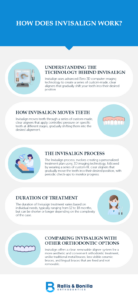How Does Invisalign Work?

Invisalign has revolutionized the way we think about orthodontic treatment, offering a discreet and comfortable alternative to traditional braces. This innovative system uses clear, custom-made aligners to gradually move teeth into their desired position without the need for metal wires or brackets. Whether you’re a teenager self-conscious about your smile or an adult seeking a discreet solution to perfect your smile, Invisalign presents an appealing option. In this blog post, we’ll talk about how Invisalign works, from the initial consultation to the moment you unveil your new smile. Our goal is to help you understand the Invisalign process so you can make an informed decision about your orthodontic treatment.
Understanding the Technology Behind Invisalign
The technology behind Invisalign is a fascinating blend of innovation and precision designed to provide a seamless, almost invisible solution for straightening teeth. Here is an overview of the key components:
- Digital Scans – Instead of traditional physical impressions using putty-like materials, we use iTero digital scanning technology. The iTero is a high-tech 3D scanner which creates a 3D model of your mouth.
- Computer Modeling – After obtaining the digital impressions, we can create a simulation of your smile before, during, and after Invisalign treatment. This allows you to see what your new smile will look like before committing to treatment.
- Aligner Fabrication – Depending on your treatment plan, a series of custom aligners is made using 3D printing technology. These aligners are made from a flexible and comfortable patented thermoplastic material.
- SmartTrack Material – Invisalign aligners use a proprietary material called SmartTrack. This material is designed to apply gentle yet constant pressure to your teeth, allowing for more predictable and efficient tooth movements.
- Treatment Monitoring – Since there are no adjustments required, you see us every six to 10 weeks–potentially even longer if you also use our Dental Monitoring system.
The integration of these advanced technologies ensures that Invisalign treatment is not only effective but also tailored to meet individual needs, offering a comfortable and aesthetically pleasing orthodontic solution.

How Invisalign Moves Teeth
Invisalign aligners are an important part of your orthodontic journey. They use a set of custom-made plastic aligners to reposition your teeth into their correct positions progressively. Here’s how they work:
- Custom Fit – Each series of aligners is designed to fit snugly over your teeth, crafted based on precise 3D images of your mouth. This custom fit ensures that the right amount of pressure is applied to specific teeth at the right time.
- Gentle Pressure – The aligners apply gentle, constant pressure to your teeth, encouraging them to move slowly over time. With each new aligner, this pressure is adjusted to focus on different teeth, following a carefully planned sequence by your orthodontist.
- Progressive Movement – You’ll switch to a new set of aligners every week. Each set is slightly different from the last, designed to move your teeth incrementally towards their final positions. This step-by-step approach ensures a controlled and predictable adjustment of your teeth.
- Removable Aligners – Unlike traditional braces, Invisalign aligners can be removed for eating, drinking, brushing, and flossing. This not only makes maintaining oral hygiene easier but also allows you to enjoy your favorite foods without restriction.
Their role in applying targeted pressure to teeth, combined with the ability to remove them as needed, makes Invisalign a popular choice for those looking to achieve a straighter smile without the drawbacks of traditional braces.
The Invisalign Process
The Invisalign process involves several key steps from start to finish. Here’s what you can expect:
- Initial Consultation – The Invisalign process begins with an initial consultation with us. During this consultation, we will assess your oral health, discuss your treatment goals, and determine whether Invisalign is the right option for you.
- Custom Treatment Plan – If you’re a good candidate for Invisalign, the next step involves taking detailed 3D digital images of your mouth. These images are used to create a precise treatment plan that maps out the movement of your teeth and estimates your treatment time.
- Receiving Your Aligners – Based on your custom treatment plan, a series of clear, plastic aligners are created specifically for your teeth. You’ll receive these aligners and instructions on how to use them. Each aligner is worn for a week before moving on to the next in the series.
- Wearing Aligners – You’ll wear your aligners for 20-22 hours per day throughout the treatment process, removing them only for eating, drinking (except water), brushing, and flossing.
- Regular Check-Ups – Throughout your treatment, you’ll have periodic check-ups with us to monitor your progress. These appointments are crucial for ensuring everything is moving according to plan.
- Transitioning Through Aligners – As you progress through each set of aligners, your teeth will gradually shift into their desired positions. The number of aligners needed varies from person to person, depending on the complexity of the tooth movements required.
- Completion of Treatment – Once you’ve gone through all your aligners, your treatment is complete! We will assess the final outcome and determine if any additional adjustments are needed to perfect your smile.
- Maintaining Your New Smile – To maintain your beautiful smile, you may need to wear a retainer at night. This ensures that your teeth stay in their new positions and helps preserve the results of your Invisalign treatment.
The Invisalign process is designed to be as seamless and unobtrusive as possible, allowing you to achieve the perfect smile you’ve always wanted with minimal impact on your daily life.
Duration of Treatment
The duration of Invisalign treatment varies depending on individual needs and the specific alignment issues being addressed. On average, treatment can last anywhere from 12 to 18 months, though some cases may be shorter or longer. Here’s what influences the length of your Invisalign journey and what you can expect:
- The complexity of Dental Issues – The nature and severity of your orthodontic issue play a significant role in determining treatment length. Simple cases with minor adjustments may take less time, while more complex situations requiring significant tooth movement may extend the treatment time.
- Wearing Schedule – The effectiveness and timeline of your Invisalign treatment are closely tied to how consistently you wear your aligners. For optimal results, it’s recommended to wear them for 20 to 22 hours per day, removing them only for eating, drinking anything other than water, and brushing your teeth.
- Response to Treatment – Individual response to treatment can also affect duration. While our scans can accurately predict tooth movement, each person’s body may respond differently to the aligners.
- Following Instructions – Attending regular check-ups and following our instructions are crucial for staying on track. Missing appointments or not switching aligners as advised can delay progress.
- Post-Treatment Adjustments – In some cases, additional aligners might be needed after the initial set to make final adjustments and ensure the best possible outcome.
We can provide you with a more personalized estimate based on your specific situation and adjust the treatment plan as needed to achieve the desired results.
Comparing Invisalign with Other Orthodontic Options
When considering orthodontic treatment to straighten your teeth, it’s important to explore all your options. Invisalign is a popular choice for many, but how does it compare to other orthodontic solutions? Let’s break down the key differences:
- Traditional Braces – Invisalign uses clear, removable aligners for a more discreet and comfortable orthodontic treatment, while traditional braces involve fixed metal brackets and wires that are more visible and can cause discomfort. In most cases, Invisalign provides faster results than traditional braces.
- Lingual Braces – Invisalign uses nearly invisible, removable aligners worn over the teeth, whereas lingual braces are fixed to the back of the teeth, making them invisible from the front but potentially more uncomfortable for the tongue.
- Ceramic Braces – Invisalign offers a nearly invisible, removable treatment option for straightening teeth, whereas ceramic braces, though less visible than metal braces, are permanently attached to the teeth for the duration of treatment.
When deciding between Invisalign and other orthodontic treatments, consider factors like aesthetics, comfort, lifestyle, and treatment goals. Consulting with an orthodontist who can assess your specific needs and preferences will help you make the best decision for your smile.
If you are looking for the perfect orthodontic solution, Rallis & Bonilla Orthodontics is here to guide you every step of the way. With our convenient locations in North Star, 84th Street, and Yankee Hill, achieving the smile of your dreams has never been easier.
Our team of experts is dedicated to providing personalized care in a welcoming environment, ensuring your comfort and satisfaction. Don’t wait any longer to transform your smile. Contact Rallis & Bonilla Orthodontics today and discover how we can make your dream smile a reality. Your journey to confidence starts here!